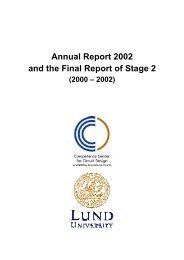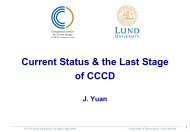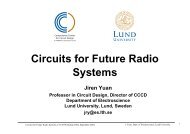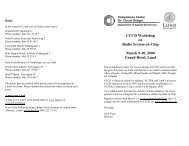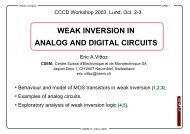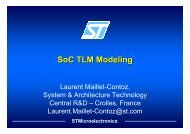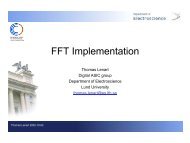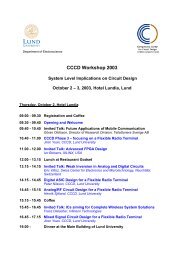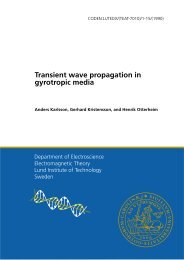Design of Antennas for Handheld DVB-H ... - Lunds tekniska högskola
Design of Antennas for Handheld DVB-H ... - Lunds tekniska högskola
Design of Antennas for Handheld DVB-H ... - Lunds tekniska högskola
Create successful ePaper yourself
Turn your PDF publications into a flip-book with our unique Google optimized e-Paper software.
2.1.5.2 Time slicing<br />
A large problem with handheld terminals is the limited battery capacity. It is<br />
impossible to receive and decode a broad band, high data-rate stream like the<br />
<strong>DVB</strong>-T data stream with a battery terminal. The receiver and demodulation part in<br />
the terminal would use too much power and the battery would run out quickly. In<br />
the beginning <strong>of</strong> the development <strong>of</strong> <strong>DVB</strong>-H it was shown that the power<br />
consumption <strong>of</strong> a <strong>DVB</strong>-T receiver is about 1 Watt, which is too much [14]. A<br />
some-what lower value seems possible but the desired target <strong>of</strong> 100 mW as a<br />
maximum threshold <strong>for</strong> the entire front end incorporated in a <strong>DVB</strong>-H terminal is<br />
still unobtainable <strong>for</strong> a <strong>DVB</strong>-T receiver.<br />
A considerable drawback <strong>for</strong> battery-operated terminals is the fact that with <strong>DVB</strong>-<br />
T, the whole data stream has to be decoded be<strong>for</strong>e any one <strong>of</strong> the services (TV<br />
programs) <strong>of</strong> the multiplex can be accessed. The main reason why <strong>DVB</strong>-H<br />
consumes less power is that the receiver only has to receive and process the parts<br />
<strong>of</strong> the data stream that contains the in<strong>for</strong>mation needed <strong>for</strong> the selected service.<br />
For this to be possible the data stream needs to be reorganized in a suitable way.<br />
With <strong>DVB</strong>-H, service multiplexing is per<strong>for</strong>med in a pure time-division<br />
multiplex. The data <strong>of</strong> one particular service are there<strong>for</strong>e not transmitted<br />
continuously but in compact periodical bursts with interruptions in between. In the<br />
interruption between bursts, other services are sent. This leads to a continuous<br />
data stream. This data stream can be received in time intervals where the receiver<br />
is synchronized with the service you want to receive. Then the receiver can be<br />
shut down when the other services that you have no interest in are sent. This way<br />
<strong>of</strong> dividing the signal is called time slicing [15].<br />
When time slicing is used to receive the signal it saves a lot <strong>of</strong> power because the<br />
receiver can be turned <strong>of</strong>f most <strong>of</strong> the time. When the receiver is on, the received<br />
signal is buffered in a memory and then read out from the buffer in the service<br />
data-rate. When the receiver is turned on the next time and receives a new data<br />
stream, this data is buffered in the memory and the video can be played<br />
continuously. For the receiver to know when it is time to turn itself on again after<br />
an <strong>of</strong>f-time, data containing in<strong>for</strong>mation about how long the receiver should be<br />
turned <strong>of</strong>f between the bursts, has to be sent in each burst.<br />
The duration <strong>of</strong> one burst is in the range <strong>of</strong> several hundred milliseconds whereas<br />
the power save time may amount to several seconds. The receiver has to be turned<br />
on be<strong>for</strong>e it is time to receive data and there<strong>for</strong>e it is turned on 50-250 ms be<strong>for</strong>e<br />
calculated receiving time. Depending on the ratio between on time and <strong>of</strong>f time,<br />
the resulting power saving may be more than 90 %.<br />
As an example, figure 2.4 shows a cut-out <strong>of</strong> a data stream containing time-sliced<br />
services. One quarter <strong>of</strong> the assumed total capacity <strong>of</strong> the <strong>DVB</strong>-T channel <strong>of</strong><br />
11



